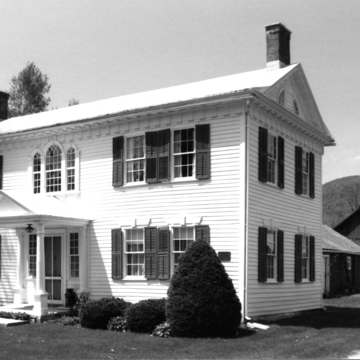This showplace house of Vermont's fifth governor mixes pragmatic self-sufficiency with the high-style sophistication brought to southwestern Vermont by Lavius Fillmore with the construction by Fillmore and colleagues of Old Bennington's Old First Church (BE27), of which Jonas Galusha was a member. Galusha arrived in Vermont from Norwich, Connecticut, via the iron-working center of Salisbury, Connecticut, and settled his Shaftsbury farm in 1773. He built the hand-hewn one-and-a-half-story rear wing of the present house in 1783. In 1805 he added a two-and-a-half-story front house with sawn timber frame, its gunstock posts flaring at the top to carry the massive girts and wall plates. Its elegant detailing included a triple-arched Palladian window and splayed lintel boards with fluted keystones. A confirmed Jeffersonian, Galusha followed the president's Doric preferences, using Tuscan columns for his porch, a full triglyph frieze, and mutules beneath the eaves. He must have utilized professional joiners for the exterior details, some of which are so close to contemporary work in Bennington that they have traditionally been attributed to Lavius Fillmore. However, the tentative handling of the roof gables and the relationship of the Palladian window to the frieze suggest another craftsman working in Fillmore's style and perhaps adding the details to a building not originally designed to receive them. Galusha himself is reputed to have forged most of the hardware and executed the interior's tiger maple staircase and distinctive fireplace paneling. The interiors are finished with blue and red stenciling and hand-painted wall and overmantel decorations in floral and arabesque designs by an itinerant artist. Other than the replacement of the original twelve-over-twelve windows with six-over-six in the 1840s, the house remains essentially in its original form.
You are here
Governor Jonas Galusha House
If SAH Archipedia has been useful to you, please consider supporting it.
SAH Archipedia tells the story of the United States through its buildings, landscapes, and cities. This freely available resource empowers the public with authoritative knowledge that deepens their understanding and appreciation of the built environment. But the Society of Architectural Historians, which created SAH Archipedia with University of Virginia Press, needs your support to maintain the high-caliber research, writing, photography, cartography, editing, design, and programming that make SAH Archipedia a trusted online resource available to all who value the history of place, heritage tourism, and learning.


